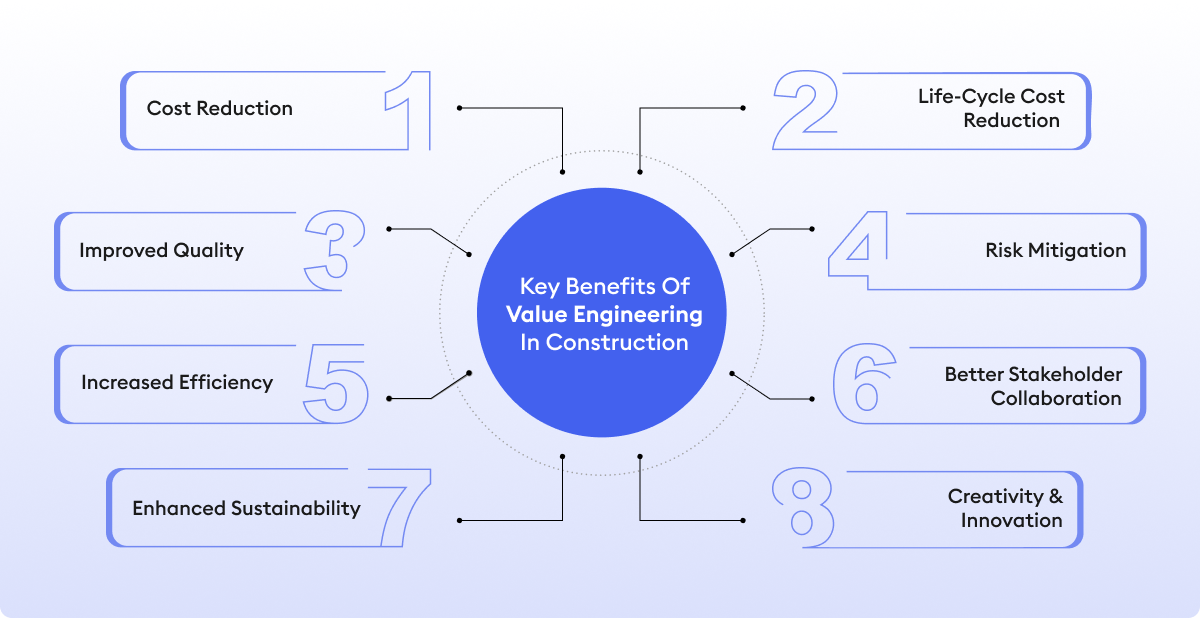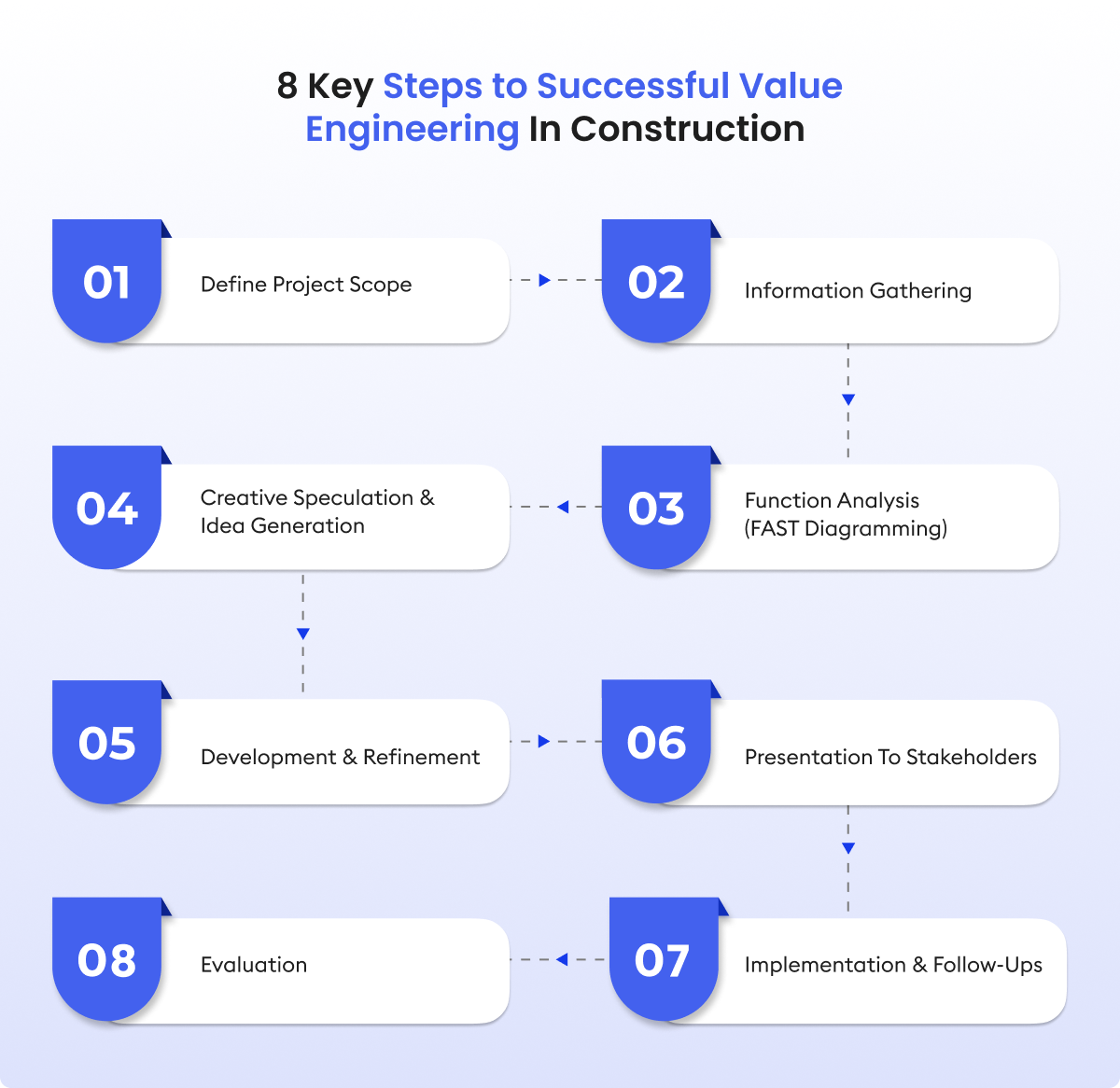Summary
Importance of value engineering in construction
The construction industry is more competitive than ever. New players are entering the market every day, and dozens of businesses are bidding for the same project. And here’s the truth: Offering the lowest price for a job is not a winning strategy. In fact, it can be a red flag.
Today, clients are looking for value. The question is: what can your construction business bring to the table that others can’t? To answer that, you first need to understand where value actually comes from.
According to McKinsey, large projects typically take 20% longer to finish and run up to 80% over budget. Add to that rising labour shortages, updated US tariffs making material costs unpredictable, and sustainability pressures, project owners and contractors need better ways to deliver value.
This is where Value Engineering in Construction makes a real difference. It provides construction businesses with a way to balance cost, function, and performance without compromising quality.
But before we dive into how it helps construction businesses win, let’s first get clear on what Value Engineering in construction actually is.
What Is Value Engineering In Construction?
First of all, don’t confuse value engineering (VE) with cost-cutting.
Value engineering in construction is a systematic process that focuses on analyzing the functions of a building or system and identifying alternative solutions that provide the same (or better) performance at a lower cost.
When you cut costs on a construction project, it usually hurts the final output. Value engineering, on the other hand, does not compromise on quality.
For example, replacing a high-cost material with a more affordable alternative may sound like cost-cutting, but when the substitute maintains durability, reduces maintenance costs, and improves life cycle performance, that’s value engineering in action.
Core Principles & Goals Of Value Engineering In Construction
The primary goals of value engineering in construction revolve around 3 key areas:
a. Lifecycle Cost Optimization
Reducing long-term costs by opting for smarter material choices, methods, or design alternatives.
b. Function-Oriented Analysis
Value engineering in construction focuses on understanding and analyzing a project's core functions rather than its physical components.
c. Collaborative & Systematic Process
Value engineering in construction involves a multi-phase process that includes the collaboration of all primary stakeholders, including architects, engineers, and contractors. This approach generates innovative, cost-optimizing solutions without compromising on construction quality.
What Are The Key Benefits Of Value Engineering In Construction
As value engineering in construction inherently involves staying within budget while maintaining quality, it offers various benefits. If applied effectively, it can be the ‘edge’ your team needs in the midst of all the competitive bids.
a. Cost Reduction
The most obvious benefit of value engineering in construction is a reduction in project costs, without sacrificing quality. This includes savings on initial construction costs through the use of material substitutes or finding lower-cost alternatives.
b. Life-cycle Cost Reduction
VE in construction extends beyond initial construction expenses and addresses long-term operational and maintenance costs. The process helps in selecting materials and systems that are more durable and require less upkeep over time, providing greater value throughout the asset's lifespan.
c. Improved Quality
Value engineering in construction helps select alternatives that improve system reliability and longevity.
d. Risk Mitigation
Catching design flaws, constructability issues, and schedule conflicts early helps avoid costly changes, delays, and rework later.
e. Increased Efficiency
Value engineering in construction streamlines workflows, eliminates redundant processes, and optimizes resource allocation.
f. Better Collaboration
VE workshops bring together primary project stakeholders —including clients, designers, engineers, and contractors—to work toward a common goal. Collaboration in construction creates a transparent and trusting environment, aligning everyone's priorities and building stronger working relationships.
g. Enhanced Sustainability
Value engineering in construction promotes the use of sustainable practices and eco-friendly alternative materials.
h. Promotes Creativity & Innovation
The creative and systematic approach of value engineering encourages project stakeholders to think outside the box.

Steps For Value Engineering In Construction
Now that we understand how VE can bring value to construction projects, let’s discuss the process. What exactly are the steps to successful value engineering in construction?

Phase 1: Define Project Scope
Chalk out the final goals of the project. This includes the size, type, stakeholder goals, and expected timelines of the job.
Phase 2: Information Gathering
Once the team has a clear and agreed-upon understanding of the project's scope and goals, you can proceed to the details. Begin reviewing any available documents that may impact the project. This includes design documents, cost estimates, material specifications, schedules, and any constraints or client requirements.
Phase 3: Function Analysis (FAST Diagramming)
Function Analysis System Technique (FAST) is a tool used to map and evaluate functions to determine the best alternatives. This phase breaks down the project into functions to determine “what it must do” versus “how it’s done today.”
Phase 4: Creative Speculation & Idea Generation
Includes brainstorming innovative ways to achieve each function under the FAST analysis.
Phase 5: Development & Refinement
Once you have identified, evaluated, and discussed the best possible solutions, it’s time to create concrete plans. This is the phase of refining the best options into detailed proposals.
Phase 6: Presentation To Stakeholders
Gaining buy-in from owners, architects, and contractors.
Phase 7: Implementation & Follow-Ups
This includes ensuring adopted solutions are executed effectively.
Phase 8: Evaluation
Once your plan is executed, it is essential to verify whether the value engineering project was successful. You must evaluate the results, i.e., assessing cost savings versus quality standards to determine if value engineering was successful.
This step-by-step method ensures that value engineering in construction is not an afterthought but an integral part of project planning.
When And Where To Apply Value Engineering For Maximum Impact
Value engineering will not be helpful if applied during the full-blown construction phase. It is most effective when used early in the project lifecycle, particularly during the planning and design phases.
At this stage, flexibility is high. Designs can be easily edited, and cost changes are far less expensive compared to modifications during construction.
That said, VE can be helpful during later stages as well, if applied correctly. The key is to involve the right stakeholders (owners, designers, engineers, and contractors) at the right time.
Essential Tools Supporting Value Engineering In Construction
Several tools enhance the VE process:
- Life Cycle Costing (LCC): Evaluates total cost over a building’s lifespan.
- Target Value Design (TVD): Ensures design stays aligned with budget targets.
- Benchmarking: Compares project practices with industry best practices.
These tools provide a data-driven foundation to support decisions and make the VE process more effective.
Before You Go
Value engineering in construction isn’t about cost-cutting. By analyzing functions, pushing stakeholders to innovate, and exploring alternatives, construction teams can deliver projects that are cost-effective, high-performing, and sustainable.
In construction,, where every dollar and deadline count, VE offers a proven pathway to balance cost, quality,, and performance—giving your construction team the tools to deliver value that sets you apart from the competition.
FAQs
1. What is value engineering in the construction industry?
Value engineering in construction is a systematic process that focuses on analyzing the functions of a building or system and identifying alternative solutions that provide the same (or better) performance at a lower cost.
2. How is value engineering different from cost-cutting?
Cost-cutting often compromises quality by removing features or using cheaper materials. Value engineering, on the other hand, focuses on more innovative solutions that deliver the same or better function at a lower life-cycle cost.
3. When should value engineering be applied?
VE is most effective during the early planning and design phases, when changes are easier and less expensive. However, it can also be applied later if done systematically.
4. What are the steps of value engineering?
Value engineering has 8 phases:
- Defining project scope
- Information gathering
- Function analysis (FAST Diagramming)
- Creative speculation & idea generation
- Development & refinement
- Presentation to stakeholders
- Implementation & follow-ups
- Evaluation
5. Who participates in the value engineering process?
Value engineering workshops typically involve clients, architects, engineers, contractors, and other stakeholders collaborating to generate and evaluate solutions.









.png)
.png)

.png)
.webp)

